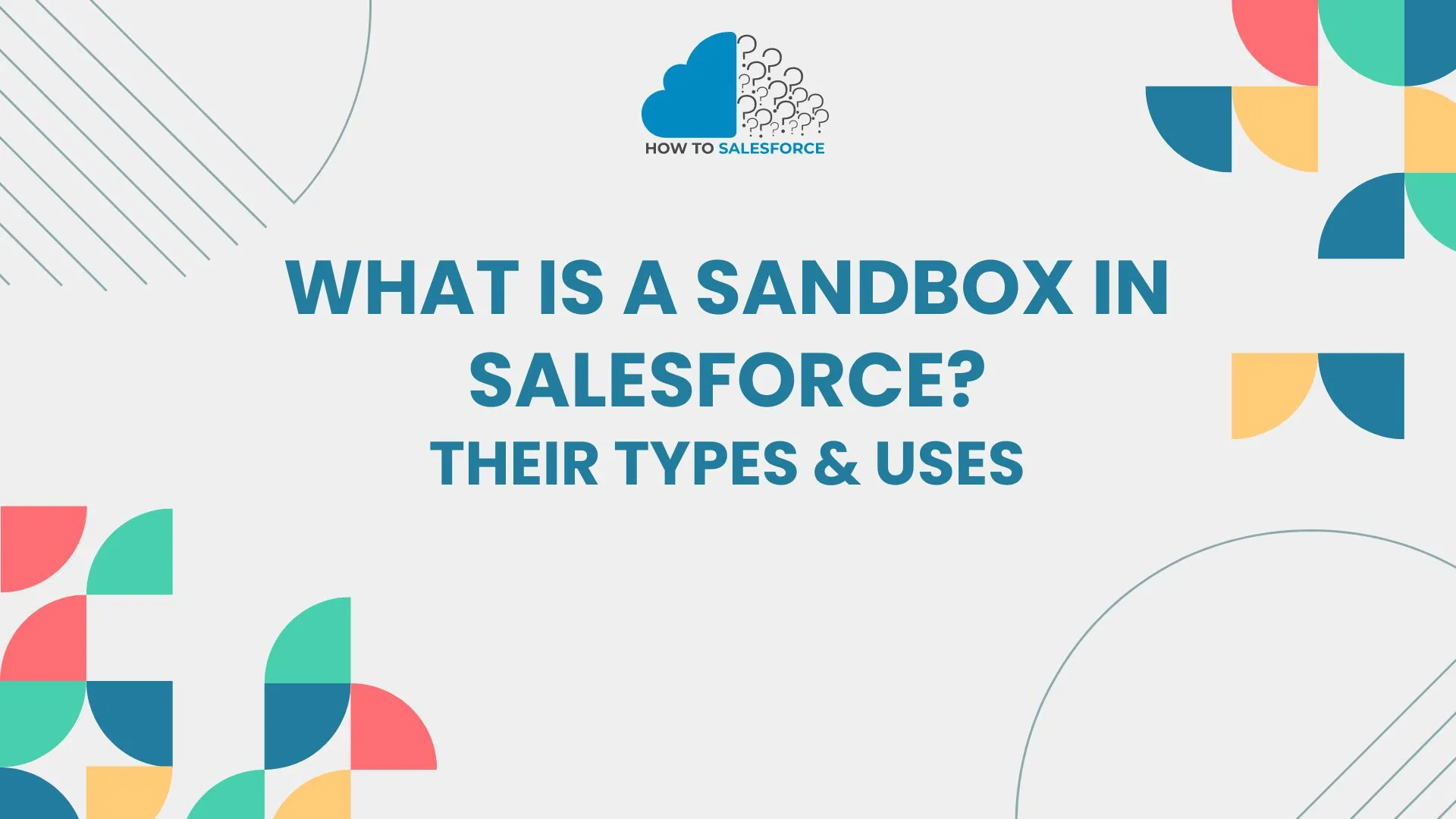Introduction
Salesforce sandboxes are separate from your live environment for training, development, and testing without compromising data. Salesforce administrators and developers may build and test new features in a secure environment before implementing them online. This article will explain what a Sandbox is in Salesforce, the many types of it, its uses, and how to use it for Salesforce operations.
Do you know what a salesforce admin is? If you don’t know, read my recent blog on this topic.
Comprehending Salesforce Sandboxes
Salesforce sandboxes replicate your live environment and contain your Salesforce settings, preferences, and data. Because of their controlled environment, sandboxes allow teams to test, learn, and develop without disrupting the natural system. They provide stability by thoroughly evaluating changes before implementing them.
Salesforce Sandbox Types
Salesforce provides a variety of sandboxes, each designed to fulfill a certain function. The secret to streamlining your workflow and guaranteeing the development and testing processes’ efficiency is understanding the various kinds of sandboxes.
1. Sandbox for Developers
Developer sandboxes are simple configuration and scripting sandboxes. This environment lets developers write and test code without production data. Developer Sandboxes only contain standard and custom objects, so you can’t test with real-world data. Development sandboxes are ideal for:
- Crafting and evaluating fresh code
- Setting up new features
- Running unit tests on minor modifications
2. Sandbox for Developer Pro
The Developer Pro Sandbox upgrades the Developer Sandbox. Due to its more storage and configuration possibilities, it can perform more complex development and testing jobs. Developer Pro Sandboxes are used to test large datasets or multiple developers on the same project. Their uses include:
- Extensive dataset testing for features
- Carrying out integration tests
- Developing more intricate procedures and workflows
3. Sandbox with Partial Copies
A partial copy sandbox is a mid-level sandbox with production data and metadata. Quality assurance and testing are typical uses. The Partial Copy Sandbox contains only a tiny fraction of your actual data but all your production environment parameters. This sandbox is often used for:
- Testing new functions in an environment similar to production, conducting quality assurance (QA) tests using real-life scenarios, and assessing performance.
4. Complete Sandbox
A Full Sandbox replicates your production environment with all settings, modifications, and data. This sandbox is ideal for performance testing, end-user training, and significant changes. Complete Sandboxes are best for this because they simulate your natural environment most realistically:
Evaluate intricate modifications using complete production data
Benchmarking performance and conducting load tests
- Testing for user acceptance (UAT)
- Providing actual data for training and onboarding new users
How Is a Salesforce Sandbox Useful?
Its main benefit is using a Salesforce sandbox to test and develop new features without affecting production. This reduces the risk of adding issues, damaging data, or modifying your production system. Salesforce development and administration require sandboxes for these reasons:
1. Secure Testing Setting
Developers and administrators can test new features, integrations, and code in a secure sandbox environment, all without influencing the operational system. This guarantees that any mistakes or faults are found quickly, before they may have an impact on how business is conducted.
2. Privacy of Data
Sandboxes assist in safeguarding your sensitive data because they are separated from your production environment. Tests, modifications, and experimentation with various settings may all be done safely without endangering the integrity or loss of data in your production instance.
3. Optimal Development Process
Sandboxes allow developers to work on numerous projects at once, which speeds up the development process. This is particularly helpful in larger teams where testing and development are ongoing activities. With sandboxes, developers may efficiently communicate, test their code, and work separately without interfering with one another’s work.
4. Orientation and Induction
Sandboxes are a great way to conduct user acceptance testing (UAT) or train new users. Sandboxes allow trainees to work with a system that mimics the real world without having to worry about messing up actual data. This is especially helpful for training new hires or evaluating how users engage with new features.
Optimal Procedures for Using Sandboxes in Salesforce
There are some best practices that you must adhere to to get the most out of your Salesforce sandboxes. Sandbox management done right lets you take full advantage of their potential while lowering risks.
1. Select the Appropriate Sandbox for the Assignment
Selecting the right sandbox for your work is essential. A Developer Sandbox is sufficient for basic coding and configuration. A Full Sandbox is better suited for more thorough testing or performance benchmarks, though. You can make sure that your process is effective and your tests are accurate by choosing the appropriate sandbox.
2. Continually Update Your Sandboxes
Salesforce lets you refresh sandboxes to match production. This ensures that your testing and development environments match your production instance. Full and Partial Copy Sandboxes may become outdated due to production changes, so this is vital.
3. Developer Sandbox Data Limits
Because the storage space in Developer Sandboxes is limited, you must handle your data with care. Instead of filling Developer Sandboxes with massive dataset imports, concentrate on using sample data to evaluate setups and code. If testing larger datasets is required, think about utilizing a Partial Copy Sandbox or Developer Pro.
4. Conduct Extensive Testing
Sandboxes allow extensive testing before production changes are made. Run rigorous unit, integration, and user acceptance tests to discover potential issues early on. Sandboxes lets you test different scenarios and uncover problems before they affect your natural environment.
5. Keep Sandbox Security Up to Date
Even while sandboxes are isolated from your production environment, sensitive data is still present there, particularly in Full Sandboxes. Applying the same security measures in your sandboxes as you would in production is important. This entails utilizing strong passwords, configuring appropriate access limits, and routinely reviewing user behavior in your sandboxes.
How to Establish a Salesforce Sandbox
The procedure of setting up a Salesforce sandbox is simple. Salesforce offers a sandbox creation and management interface that is easy to use. Here’s how to set up a Salesforce sandbox step-by-step:
1. Open the Configuration Menu
Go to the Setup menu after logging into Salesforce to start a new sandbox. Type “Sandboxes” into the Quick Find search bar, then select the Sandboxes link.
2. Build a Brand-New Sandbox
Click the “New Sandbox” button once you’re on the Sandboxes page. This will direct you to the page where you may create a sandbox, where you can choose between the Developer, Developer Pro, Partial Copy, and Full sandbox types.
3. Give Your Sandbox a Name
Give your sandbox a name that accurately describes what it is used for (e.g., “Development_Sandbox” or “UAT_Sandbox”). You must select a name that is both clear and short because Salesforce will automatically append the name to the name of your organization.
4. Select the Type of Sandbox
Choose the kind of sandbox that will work best for you. When choosing, take into account the data that is needed, the storage constraints, and the testing complexity.
5. Set Up Metadata and Data
You can select the metadata and data to include in your sandbox for both partial copy and full sandboxes. The data you wish to duplicate in the sandbox can also be specified in a sandbox template that you define.
6. Build the Sandbox
Click “Create” once the data has been configured and your selections have been chosen. Your sandbox will be created by Salesforce, and you’ll be notified when it’s prepared for usage.
Conclusion
Finally, a Salesforce sandbox is essential for development, testing, and training. Developers and administrators can test new features, configure settings, and train users in sandboxes without compromising the natural system. Teams perform better when they understand sandbox types and uses.
Following best practices and using the right sandbox type can optimize Salesforce development and testing. Any company that uses Salesforce for CRM needs sandboxes to maintain stability and performance.


